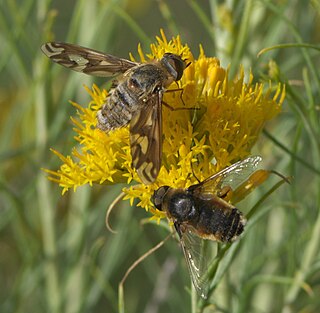
The Bombyliidae are a family of flies, commonly known as bee flies. Some are colloquially known as bomber flies. Adults generally feed on nectar and pollen, some being important pollinators. Larvae are mostly parasitoids of other insects.

Poecilanthrax willistonii, Williston's bee fly or sand dune bee fly, is a member of the Bombyliidae insect family. This family includes the bee flies, true flies that have developed Batesian mimicry characteristics to avoid predators. That is, they look like bees because that helps them avoid bee-wary predators, but they lack stingers.
Systropus arizonicus is a species of bee fly in the family Bombyliidae. It is found in Mexico and Arizona.

Systropus is a genus of bee flies in the family Bombyliidae. There are over 200 described species in the genus Systropus, found on every continent except Antarctica.

Toxophorinae is a subfamily of bee flies in the family Bombyliidae. There are five living genera and two extinct genera containing more than 400 described species in Toxophorinae.
Bombylius albicapillus is a species of bee fly in the family Bombyliidae. It occurs in western North America.
Systropus bicornis is a species of bee fly in the family Bombyliidae. It is found in Mexico.
Systropus macer is a species of bee fly in the family Bombyliidae. It is found in eastern North America in Ontario, Canada, and in the United States from Massachusetts south to Georgia and Texas. It is a parasitoid of Limacodidae caterpillars, including Adoneta spinuloides, Euclea delphinii, Lithacodes fasciola, Prolimacodes badia, and Parasa indetermina.
Exoprosopa anomala is a species of bee fly in the family Bombyliidae.
Exoprosopa ingens is a species of bee fly in the family Bombyliidae.
Exoprosopa butleri is a species of bee fly in the family Bombyliidae.
Apolysis sigma is a species of bee fly in the family Bombyliidae. It is widespread in North America.
Apolysis is a genus of bee flies in the family Bombyliidae. There are almost 120 described species in Apolysis.
Paravilla fumosa is a species of bee fly in the family Bombyliidae. It is found in California.

Neodiplocampta miranda is a species of bee fly in the family Bombyliidae. It is found in the southern United States from Florida to California, and south through Mexico into Nicaragua.
Bombylius anthophilus is a species of bee flies in the family Bombyliidae.
Paravilla aridula is a species of bee fly in the family Bombyliidae. It is found in Arizona and California.
Hemipenthes inops is a species of bee fly in the family Bombyliidae. It is found in the western United States. It is somewhat unusual compared to other members of the genus Hemipenthes in that its wings are mostly transparent.

Anastoechus barbatus is a species of bee fly in the family Bombyliidae. It is found in Canada from the Yukon east to Ontario, and across most of the United States from Massachusetts west to California and Texas, but is absent from the southeast. Its larvae are predators of grasshopper eggs.
Lepidanthrax arnaudi is a species of bee fly in the family Bombyliidae. It is found in California.





